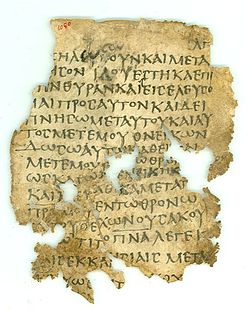| New Testament manuscript | |
 | |
| Name | P. Oxy. 1080 |
|---|---|
| Text | Revelation 3:19-4:3 |
| Date | 4th century |
| Script | Greek |
| Found | Oxyrhynchus |
| Now at | Princeton Theological Seminary |
| Size | 9.3 cm × 7.7 cm (3.7 in × 3.0 in) |
| Type | Alexandrian text-type |
| Category | III |
Uncial 0169 (in the Gregory-Aland numbering), known also as the Princeton fragment, is a Greek uncial manuscript of the New Testament, dated palaeographically to the 4th century.